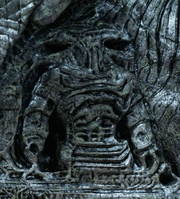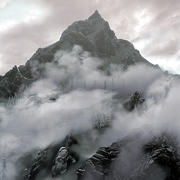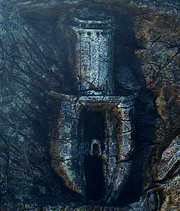The White-Gold Tower.
- "They are magical and physical echoes of the Ur-Tower, Ada-mantia. Ada-mantia was the first spike of unassailable reality in the Dawn, otherwise called the Zero Stone. The powers at Ada-mantia were able to determine through this Stone the spread of creation."
- ―Nu-Mantia Intercept
The Towers are a concept in The Elder Scrolls lore that focuses on the metaphysics surrounding the creation of Mundus. It draws largely from a series of texts known as Nu-Mantia Intercept written by Michael Kirkbride, former writer and designer for Bethesda Softworks.
According to these texts, a mysterious character named Nu-Hatta addresses a letter to Chancellor Ocato and the Elder Council warning that the barriers between Mundus and the realms of Oblivion are weakening. The letter forshadows the invasion of Mehrunes Dagon during the events of The Elder Scrolls IV: Oblivion and explains the creation and purpose of the Adamantine Tower.
What are the Towers?
The Towers are various constructs, both natural and artificial, located all across Nirn. Their existence ensures Mundus remains stabilized as they uphold the barriers between the mortal plane and the realms of Oblivion.[OOG 1]
Each tower bears a stone that serves as it's heart and provides it with stability and power. If a stone is ever removed from a tower or destroyed, the tower becomes inert or deactivated. Should all existing towers fail, Mundus itself would cease to exist.[OOG 2]
Creation of Mundus
Auri-El as depicted by the Snow Elves during the Merethic Era.
To fully grasp the concept of the Towers, it's important to understand their origins. When Mundus was originally created, several Et'Ada became dissatisfied with their creation and left the mortal plane. One of the most notable was Magnus, the god of magic and the architect of Mundus.[1][2] In his departure to Aurbis he tore a hole into Aetherius, which became the sun. Soon after many other Et'Ada followed him, they became known as the Magna Ge and left smaller holes in the sky, which became the stars.[OOG 3][OOG 4]
Convention
After the departure of the Et'Ada, Akatosh/Auri-El returned to Mundus and arranged a meeting of the remaining Aedra outside aurbic time.[1] The purpose of this meeting, known as Convention, was to decide Lorkhan's punishment for his involvement in the creation of Mundus.[1][OOG 5]
Akatosh's vessel planted itself into Nirn and became the Adamantine Tower, also known as Ada-mantia or Ur-Tower, and it was on this first tower that the Convention took place: [OOG 5]
- "Auriel-that-is-Akatosh returned to Mundex Arena from his dominion planet, signaling all Aedra to convene at a static meeting that would last outside of aurbic time. His sleek and silver vessel became a spike into the changing earth and the glimmerwinds of its impact warned any spirit that entered aura with it would become recorded-- that by consent of presence their actions here would last of a period unassailable, and would be so whatever might come later to these spirits, even if they rejoined the aether or succumbed willingly or by treachery to a sithite erasure. Thus could the Aedra and their cohorts truly covene in realness."
- ―Nu-Mantia Intercept, Letter #4
The Zero Stone
The concept of the Stone is also introduced, specifically the Zero Stone. When Ada-mantia was created, its stone was the Convention itself. This Zero Stone also became the basis for every other stone that came after.[OOG 2]
- "Our forebears saw the erection of Ada-mantia, Ur-Tower, and the Zero Stone. Let the Elders acknowledge this truth: every Tower bears its Stone. The impossipoint of the Convention was the first, though another bears the true title of First Stone."
- ―Nu-Mantia Intercept, Letter #4
Stones themselves are magical or physical constructs that allow a tower to focus its energy in order to mold creation. The stones are imbued with creatia magic that comes directly from Aetherius, however stones were often borrowed from the realm of Oblivion and grafted to the tower, as this was much easier than trying to access Aetherius.
Heart of Lorkhan
Red Mountain formed on the island of Vvardenfell.
The outcome of the Convention was to separate Lorkhan from his divine heart as punishment for his role in the creation of Mundus. Trinimac tore out Lorkhan's heart and Auri-El fastened it to an arrow and shot it into the sea where Red Mountain eventually formed.[3]
The Red Mountain became the second Tower and its stone was the Heart of Lorkhan, also known as the First Stone. The Heart of Lorkhan granted Mundus with a special kind of divinity and allowed the remaining Et'Ada to leave without it becoming unraveled, while the Zero Stone provided linearity of existence.[OOG 1] The Et'Ada who remained either died or eventually degenerated into the Ehlnofey, the progenitors of man and mer.[1]
Each tower bears one of these focusing stones that provides it with stability and power. If a stone is ever removed from a tower or the link between the stone and tower is severed, the tower becomes deactivated.
Aldmeri schism
- "He then ascended to heaven in full observance of his followers so that they might learn the steps needed to escape the mortal plane."
- ―Varieties of Faith in the Empire
The most powerful of lesser spirits in the time after the Convention were the Aldmer. Upon witnessing their chief deity, Auri-El, leave Mundus, they were eager to follow in his footsteps. They sought to emulate the two existing Towers so they built several of their own in order to achieve divinity.
Eventually, the Aldmer began to split into distinct cultural groups that gave birth to the various races of Mer, such as the Altmer, Dwemer, Chimer and Ayleids. Each race attempted to achieve divinity in their own way. The Altmer built Crystal-Like-Law, the Ayleids founded White Gold Tower and the Dwemer created the Numidium.
Nu-Hatta asserts that the continent of Aldmeris, the supposed original homeland of the Aldmer, is a myth. He explains the "destruction of Aldmeris" was in fact the schism that took place between the Aldmer, and that the concept of Aldmeris or Old Ehlnofey was simply a set of shared ideals Elves held at the beginning of time. He concludes this with the statement that all mortal life began on Tamriel.[OOG 1]
Known Towers
The exact number of towers is unknown. Ada-Mantia and the Red Tower are the only two that were created by the et'Ada, most of the others were made by the various races of Mer.
Ada-Mantia
Ada-Mantia as seen in The Elder Scrolls II: Daggerfall
The Adamantine Tower, also known as the Direnni Tower was the first Tower. It was created on the island of Balfiera in the Illiac Bay and is believed to be the oldest known structure in Tamriel.[1] It is considered an active tower and its stone is known as the Zero Stone, which is the Convention.
Red Tower
Red Mountain was the second Tower that was created when Auri-El and Trinimac killed Lorkhan and shot his heart into Vvardenfell.[1] Red Mountain grew around its stone, the Heart of Lorkhan, and it granted a special kind of divinity to Mundus. With two Towers in place Mundus was stable, so Auri-El and several other Aedra left the mortal plane. The Aldmer, seeking to follow Auri-El and achieve divinity, began to construct their own Towers.
The Red Tower was deactivated at the conclusion of The Elder Scrolls III: Morrowind when the Nerevarine infiltrated Dagoth Ur's citadel and destroyed the various power tapping enchantments placed around the Heart of Lorkhan. Once the enchantments were destroyed, the Heart disappeared. The mountain later erupted in 4E 05.[4]
Crystal-like-Law
The Crystal Tower is located in Alinor in the Summerset Isle.[1] It was built by the Altmer in ancient times and served as the pinnacle of arcane research, predating the Arcane University and College of Winterhold.[5][6] During the Oblivion Crisis, it was turned over to the Thalmor[7], however it was attacked and destroyed by legions of Daedra.[8] Its stone was said to be "a person".[OOG 6]
White Gold
The White Gold Tower as seen in The Elder Scrolls IV: Oblivion
The White-Gold Tower is the ancient structure which dominates the Imperial City in Cyrodiil. It was built by the Ayleids as a means of refocusing the powers of creation to reach divinity, rather than let the power of magic disseminate.
Although the tower was built with a central spire the structure itself resembles the Wheel, with eight lesser towers forming a ring around it. This formation is described as a unique "Wheel within the Wheel" and gives the White-Gold Tower a power over creatia unlike any of the other Towers. While other Towers bind magic and bleed it, the White-Gold Tower harnessed the power of creation.[OOG 7]
Its stone was the Chim-el Adabal, the central gemstone within in the Amulet of Kings.[OOG 2] During the events of The Elder Scrolls IV: Oblivion the Amulet was destroyed, which in turn deactivated the Tower, however it may have been reactivated with the intervention of Akatosh's avatar at the Temple of the One.
According to the Prophecy of the Dragonborn recorded on Alduin's Wall, the fall of the White Tower occurred during the Oblivion Crisis - "When the Dragonborn Ruler loses his throne, and the White Tower falls".[9][7]
Orichalc
The Orichalc Tower was believed to have been located on the continent of Yokuda. It was built by the Lefthanded Elves and is likely to have been constructed from Orichalcum.[2] The Tower was deactivated when a Redguard attempted to perform the swordstroke "Pankratosword" and Yokuda sank into the ocean.[OOG 8] Its stone was said to be "a sword".[OOG 6]
Walk-Brass

"When the Brass Tower walks and Time is reshaped..."
- Prophecy of the Dragonborn
Walk Brass, also known as the Brass Tower [9], is the Numidium - the brass god created by the Dwemer. During the Battle of Red Mountain in 1E 700, the entire Dwemer race disappeared.[10] It sat dormant until it was traded to Tiber Septim by the Tribunal for autonomy from Cyrodiil. It was used to assault the Second Aldmeri Dominion and unite the Empire. It was later destroyed by Zurin Arctus, the Underking.
During the events of The Elder Scrolls II: Daggerfall it was rebuilt and used again, which resulted in the Warp in the West, after which it disappeared from existence.[11]
Its stone was originally the Heart of Lorkhan. The Mantella, a powerful soul gem that contained the oversoul of Talos, Zurin Arctus and Ysmir, was used as its replacement after the disappearance of the Dwemer.[12]
Green-Sap
Green-Sap is believed to be the giant walking tree city in Valenwood known as Falinesti. In the late Third Era the city stopped walking and rooted itself for the first time in recorded history.[13] It is unknown if this is an indication of its deactivation. Its stone is said to be "a fruit".[OOG 6]
Snow Throat

Snow Throat as seen in The Elder Scrolls V: Skyrim
Snow Throat, also known as the Snow Tower,[9] is typically interpreted as the Throat of the World in Skyrim. According to the Prophecy of the Dragonborn, the Snow Tower lies "sundered, kingless, bleeding" in the Fourth Era.
Its stone is said to be "The Cave".[OOG 6]. The peak is described as being only half there [OOG 7] - this alludes to the time wound and the Dragon Break that occurred at the summit during the Dragon War.
Deactivation of the Towers
Because the Towers maintain the barriers between the mortal plane and Oblivion, whenever one is deactivated or destroyed, the barrier weakens.
A Tower can be deactivated in a number of ways. These include the destruction of the Tower, its Stone or by severing the link between the Tower and the Stone that powers it. An example of this is when Emperor Uriel VII was killed during Oblivion. This event temporarily severed the link between White-Gold Tower and its Stone, the Amulet of Kings. This in turn weakened the barriers of the mortal plane and the Oblivion Crisis was the result, as foretold by Nu Hatta.
In another text written by Michael Kirkbride, called the Altmeri commentary on Talos, talks of a Thalmor plot regarding Talos and man. The text essentially reveals the Aldmeri Dominion are possibly involved in a master plan where they wish to undo the mortal plane itself by deactivating the last known Towers.
To kill Man is to reach Heaven, from where we came before the Doom Drum's iniquity. When we accomplish this, we can escape the mockery and long shame of the Material Prison.
To achieve this goal, we must:
- Erase the Upstart Talos from the mythic. His presence fortifies the Wheel of the Convention, and binds our souls to this plane.
- Remove Man not just from the world, but from the Pattern of Possibility, so that the very idea of them can be forgotten and thereby never again repeated.
- With Talos and the Sons of Talos removed, the Dragon will become ours to unbind. The world of mortals will be over. The Dragon will uncoil his hold on the stagnancy of linear time and move as Free Serpent again, moving through the Aether without measure or burden, spilling time along the innumerable roads we once traveled. And with that we will regain the mantle of the imperishable spirit.
Fallen gods
According to the Aldmeri creation myth, the Aldmer were once gods. Lorkhan tricked the other Aedra into creating Mundus, thus trapping their descendents, the Aldmer, as mortals. They considered this a great cruelty as they were severed from their divine roots.
As time passed and the various races of Mer emerged, not all saw their mortality as a negative. The Psijic Order accepted their mortality and meditate on it. The Dunmer see their mortality as a challenge. Many Altmer seek to re-achieve divinity through other means, such as following Auri-El's example.
Thalmor endgame

"When the Dragonborn Ruler loses his throne, and the White Tower falls."
- Prophecy of the Dragonborn
According to this text, in the Fourth Era the Third Aldmeri Dominion adopted a militant stance on the matter and sought to return to immortality at any cost.
This harsh course of action was the result of the Altmer no longer having the knowledge of reaching divinity that Auri-El taught their ancestors. Because of this they see no need in the Towers. They are no longer gateways to Aetherius from their material prison, but rather the iron bars in their prison cell. The Aldmeri Dominion therefore wish to smash these bars and escape the mortal plane.
Their method of achieving divinity first involves removing Talos, god-king of man, from the pantheon of worship. In a world where the beliefs of it's inhabitants has a direct influence on the Gods, stopping the worship of Talos would cause him to cease to exist and therefore no longer be an obstacle in the Thalmor's scheme. This part of the scheme was partially realized with the sack of the Imperial City during the Great War and the introduction of the White-Gold Concordat, the law that forbid Talos worship in the Empire.[7]
The "Sons of Talos" or Men are also seen as an obstacle, so they seek to remove Man from the equation. Simply killing every human would not suffice, rather the very notion of man must be eliminated. This would be achieved by deactivating the aformentioned Towers that hold up Mundus.
By the Fourth Era several Towers have already been deactivated or destroyed, namely Red Tower, Crystal Tower, Orichalc and Walk Brass. The White-Gold may have been reactivated with the intervention of Akatosh at the Temple of the One during the Oblivion Crisis and it's unknown if Green-Sap or Snow Throat are active or not.
Once these two goals have been achieved, the Thalmor's master plan of achieving divinity would be complete. If all the Towers were deactivated, the eternal cycle of death would cease and Mundus would dissolve back into its original primordial state, unbound by the laws of physics and reality; time and space would have no meaning, neither would despair or discord.
Further reading
- The Imperial Library - Facts and Opinions from the Nu-Hatta Intercept
- The Elder Lore podcast - The Towers
References
- ↑ 1.0 1.1 1.2 1.3 1.4 1.5 1.6 Before the Ages of Man
- ↑ 2.0 2.1 Varieties of Faith in the Empire
- ↑ The Monomyth
- ↑ History of Raven Rock, Vol. I
- ↑ Pocket Guide to the Empire, Third Edition: Summerset Isles
- ↑ The Sage
- ↑ 7.0 7.1 7.2 The Great War
- ↑ Rising Threat, Vol. I
- ↑ 9.0 9.1 9.2 The Book of the Dragonborn
- ↑ Pocket Guide to the Empire, First Edition: Hammerfell
- ↑ Events of The Elder Scrolls II: Daggerfall
- ↑ The Arcturian Heresy
- ↑ Pocket Guide to the Empire, Third Edition: Valenwood
- ↑ 1.0 1.1 1.2 Nu-Mantia Intercept, Letter #5
- ↑ 2.0 2.1 2.2 Nu-Mantia Intercept, Letter #7
- ↑ Vehk's Book of Hours, concerning the Dragon Break
- ↑ Cosmology
- ↑ 5.0 5.1 Nu-Mantia Intercept, Letter #4
- ↑ 6.0 6.1 6.2 6.3 Michael Kirkbride Q&A Chatlog, Oct 15 2013
- ↑ 7.0 7.1 Nu-Mantia Intercept, Letter #8
- ↑ Lord Vivec's Sword-Meeting With Cyrus the Restless
